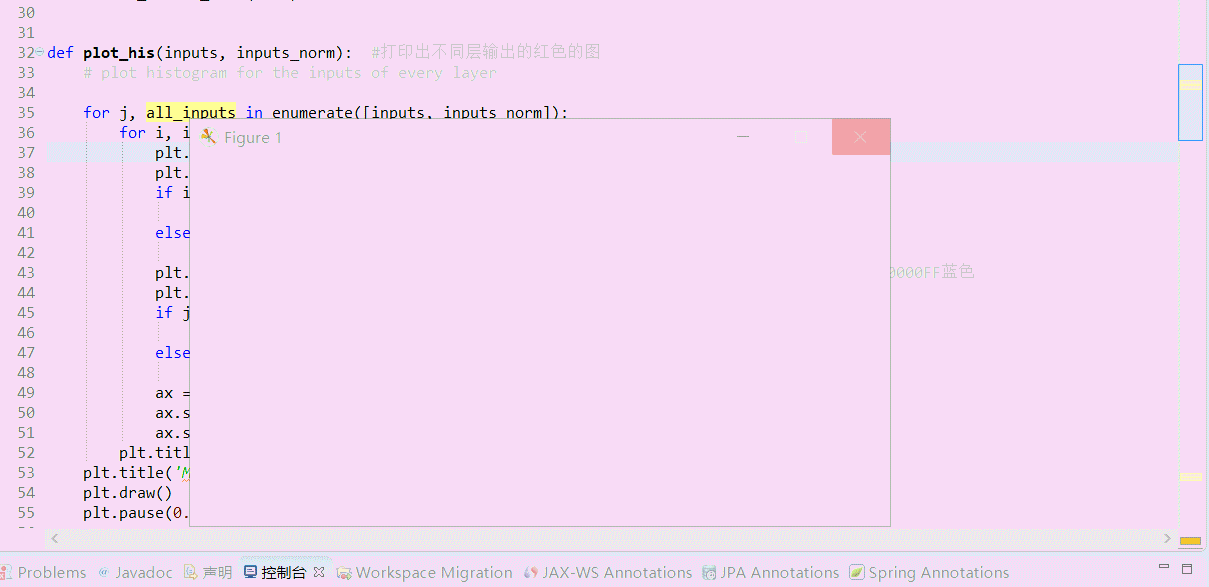TF之BN:BN算法对多层中的每层神经网络加快学习QuadraticFunction_InputData+Histogram+BN的Error_curve
# 23 Batch Normalization import numpy as np
import tensorflow as tf
import matplotlib.pyplot as plt ACTIVATION = tf.nn.tanh
N_LAYERS = 7
N_HIDDEN_UNITS = 30 def fix_seed(seed=1):
# reproducible
np.random.seed(seed)
tf.set_random_seed(seed) def plot_his(inputs, inputs_norm):
# plot histogram for the inputs of every layer for j, all_inputs in enumerate([inputs, inputs_norm]):
for i, input in enumerate(all_inputs):
plt.subplot(2, len(all_inputs), j*len(all_inputs)+(i+1))
plt.cla()
if i == 0:
the_range = (-7, 10)
else:
the_range = (-1, 1)
plt.hist(input.ravel(), bins=15, range=the_range, color='#0000FF')
plt.yticks(())
if j == 1:
plt.xticks(the_range)
else:
plt.xticks(())
ax = plt.gca()
ax.spines['right'].set_color('none')
ax.spines['top'].set_color('none')
plt.title("%s normalizing" % ("Without" if j == 0 else "With"))
plt.title('Matplotlib,BN,histogram--Jason Niu')
plt.draw()
plt.pause(0.001) def built_net(xs, ys, norm):
def add_layer(inputs, in_size, out_size, activation_function=None, norm=False):
# weights and biases (bad initialization for this case)
Weights = tf.Variable(tf.random_normal([in_size, out_size], mean=0., stddev=1.))
biases = tf.Variable(tf.zeros([1, out_size]) + 0.1) # fully connected product
Wx_plus_b = tf.matmul(inputs, Weights) + biases # normalize fully connected product
if norm:
# Batch Normalize
fc_mean, fc_var = tf.nn.moments(
Wx_plus_b,
axes=[0], )
scale = tf.Variable(tf.ones([out_size]))
shift = tf.Variable(tf.zeros([out_size]))
epsilon = 0.001 # apply moving average for mean and var when train on batch
ema = tf.train.ExponentialMovingAverage(decay=0.5)
def mean_var_with_update():
ema_apply_op = ema.apply([fc_mean, fc_var])
with tf.control_dependencies([ema_apply_op]):
return tf.identity(fc_mean), tf.identity(fc_var)
mean, var = mean_var_with_update() Wx_plus_b = tf.nn.batch_normalization(Wx_plus_b, mean, var, shift, scale, epsilon) # Wx_plus_b = (Wx_plus_b - fc_mean) / tf.sqrt(fc_var + 0.001) #进行BN一下
# Wx_plus_b = Wx_plus_b * scale + shift # activation
if activation_function is None:
outputs = Wx_plus_b
else:
outputs = activation_function(Wx_plus_b) return outputs #输出激活结果 fix_seed(1) if norm:
# BN for the first input
fc_mean, fc_var = tf.nn.moments(
xs,
axes=[0],
)
scale = tf.Variable(tf.ones([1]))
shift = tf.Variable(tf.zeros([1]))
epsilon = 0.001
# apply moving average for mean and var when train on batch
ema = tf.train.ExponentialMovingAverage(decay=0.5)
def mean_var_with_update():
ema_apply_op = ema.apply([fc_mean, fc_var])
with tf.control_dependencies([ema_apply_op]):
return tf.identity(fc_mean), tf.identity(fc_var)
mean, var = mean_var_with_update()
xs = tf.nn.batch_normalization(xs, mean, var, shift, scale, epsilon) # record inputs for every layer
layers_inputs = [xs] # build hidden layers
for l_n in range(N_LAYERS):
layer_input = layers_inputs[l_n]
in_size = layers_inputs[l_n].get_shape()[1].value output = add_layer(
layer_input, # input
in_size, # input size
N_HIDDEN_UNITS, # output size
ACTIVATION, # activation function
norm, # normalize before activation
)
layers_inputs.append(output) # build output layer
prediction = add_layer(layers_inputs[-1], 30, 1, activation_function=None) cost = tf.reduce_mean(tf.reduce_sum(tf.square(ys - prediction), reduction_indices=[1]))
train_op = tf.train.GradientDescentOptimizer(0.001).minimize(cost)
return [train_op, cost, layers_inputs] fix_seed(1)
x_data = np.linspace(-7, 10, 2500)[:, np.newaxis] #水平轴-7~10
np.random.shuffle(x_data)
noise = np.random.normal(0, 8, x_data.shape)
y_data = np.square(x_data) - 5 + noise xs = tf.placeholder(tf.float32, [None, 1]) # [num_samples, num_features]
ys = tf.placeholder(tf.float32, [None, 1]) #建立两个神经网络作对比
train_op, cost, layers_inputs = built_net(xs, ys, norm=False)
train_op_norm, cost_norm, layers_inputs_norm = built_net(xs, ys, norm=True) sess = tf.Session()
if int((tf.__version__).split('.')[1]) < 12 and int((tf.__version__).split('.')[0]) < 1:
init = tf.initialize_all_variables()
else:
init = tf.global_variables_initializer()
sess.run(init) # record cost
cost_his = []
cost_his_norm = []
record_step = 5 plt.ion()
plt.figure(figsize=(7, 3))
for i in range(250):
if i % 50 == 0:
# plot histogram
all_inputs, all_inputs_norm = sess.run([layers_inputs, layers_inputs_norm], feed_dict={xs: x_data, ys: y_data})
plot_his(all_inputs, all_inputs_norm) # train on batch每一步都run一下
sess.run([train_op, train_op_norm], feed_dict={xs: x_data[i*10:i*10+10], ys: y_data[i*10:i*10+10]}) if i % record_step == 0:
# record cost
cost_his.append(sess.run(cost, feed_dict={xs: x_data, ys: y_data}))
cost_his_norm.append(sess.run(cost_norm, feed_dict={xs: x_data, ys: y_data})) #以下是绘制误差值Cost误差曲线的方法
plt.ioff()
plt.figure()
plt.title('Matplotlib,BN,Error_curve--Jason Niu')
plt.plot(np.arange(len(cost_his))*record_step, np.array(cost_his), label='no BN') # no norm
plt.plot(np.arange(len(cost_his))*record_step, np.array(cost_his_norm), label='BN') # norm
plt.legend()
plt.show()

TF之BN:BN算法对多层中的每层神经网络加快学习QuadraticFunction_InputData+Histogram+BN的Error_curve的更多相关文章
- Batch Normalization的算法本质是在网络每一层的输入前增加一层BN层(也即归一化层),对数据进行归一化处理,然后再进入网络下一层,但是BN并不是简单的对数据进行求归一化,而是引入了两个参数λ和β去进行数据重构
Batch Normalization Batch Normalization是深度学习领域在2015年非常热门的一个算法,许多网络应用该方法进行训练,并且取得了非常好的效果. 众所周知,深度学习是应 ...
- 信息检索中的TF/IDF概念与算法的解释
https://blog.csdn.net/class_brick/article/details/79135909 概念 TF-IDF(term frequency–inverse document ...
- 深度学习归一化:BN、GN与FRN
在深度学习中,使用归一化层成为了很多网络的标配.最近,研究了不同的归一化层,如BN,GN和FRN.接下来,介绍一下这三种归一化算法. BN层 BN层是由谷歌提出的,其相关论文为<Batch No ...
- 任意半径局部直方图类算法在PC中快速实现的框架。
在图像处理中,局部算法一般来说,在很大程度上会获得比全局算法更为好的效果,因为他考虑到了图像领域像素的信息,而很多局部算法可以借助于直方图获得加速.同时,一些常规的算法,比如中值滤波.最大值滤波.最小 ...
- 06 - 从Algorithm 算法派生类中删除ExecuteInformation() 和ExecuteData() VTK 6.0 迁移
在先前的vtk中,如vtkPointSetAlgorithm 等算法派生类中定义了虚方法:ExecuteInformation() 和 ExecuteData().这些方法的定义是为了平稳的从VTK4 ...
- 1145: 零起点学算法52——数组中删数II
1145: 零起点学算法52--数组中删数II Time Limit: 1 Sec Memory Limit: 64 MB 64bit IO Format: %lldSubmitted: 293 ...
- KMP算法 --- 在文本中寻找目标字符串
KMP算法 --- 在文本中寻找目标字符串 很多时候,为了在大文本中寻找到自己需要的内容,往往需要搜索关键字.这其中就牵涉到字符串匹配的算法,通过接受文本和关键词参数来返回关键词在文本出现的位置.一般 ...
- 剑指Offer——算法复杂度中的O(logN)底数是多少
剑指Offer--算法复杂度中的O(logN)底数是多少 前言 无论是计算机算法概论.还是数据结构书中,关于算法的时间复杂度很多都用包含O(logN)这样的描述,但是却没有明确说logN的底数究竟是多 ...
- 机器学习算法中如何选取超参数:学习速率、正则项系数、minibatch size
机器学习算法中如何选取超参数:学习速率.正则项系数.minibatch size 本文是<Neural networks and deep learning>概览 中第三章的一部分,讲机器 ...
随机推荐
- Confluence 6 选择一个外部数据库
注意: 选择一个合适的数据库通常需要花费很多时间.同时 Confluence 自带的 XML 数据备份和恢复功能通常也不适合合并和备份有大量数据的数据库.如果你想在系统运行后进行数据合并,你通常需要使 ...
- Confluence 6 使用主题
主题是被用来修改 Confluence 站点或空间的外观的. Confluence 安装了一个单一的默认主题,或者你也可以下载和安装其他的主题.你可以从 The Atlassian Marketpla ...
- 【Windows】添加定时任务不执行
[问题]windows定时任务不执行.在“所有程序->附件->系统工具->任务计划程序”中添加了定时调用“D:\sys_task\bugmanager\run.bat”脚本的任务计划 ...
- 【linux】环境变量配置
假设要添加环境变量 JAVA_HOME 1.先用自己的个人账号 vim /etc/profile 在文件末尾添加 export JAVA_HOME=/usr/java/jdk1..0_144 2. s ...
- Fatal error: Uncaught Error: Call to undefined function mysqli_connect()
sudo apt-get install php7.2-mysql //版本号肯能不一样 sudo dpkg-reconfigure php7.2-mysql sudo /etc/init.d/m ...
- django----图书管理
待完成 from django.db import models # Create your models here. class Book(models.Model): nid = models.A ...
- Imperial roads 非严格次小生成树
cf测评姬比uva快了五倍... /* 不管这条边是不是在mst上,直接跑lca求出路径上的最大边w即可 ans=mst-w+dist(u,v) */ #include<bits/stdc++. ...
- 一个小时就能理解Java的NIO必须掌握这三大要素!
同步与阻塞 同步和异步是针对应用程序和内核的交互而言的. 同步:执行一个操作之后,进程触发IO操作并等待(阻塞)或者轮询的去查看IO的操作(非阻塞)是否完成,等待结果,然后才继续执行后续的操作. 异步 ...
- eclipse检出SVN项目的正确步骤
一.在工作空间新建工作目录:workspace-xf 二.在工作目录下workspace-xf 新建文件夹 tdvs ,进入该文件夹鼠标右键:SVN CheckOut 检出需要的项目 三.打开ecl ...
- python基础复习
复习-基础 一.review-base 其他语言吗和python的对比 c vs Python c语言是python的底层实现,解释器就是由python编写的. c语言开发的程序执行效率高,开发现率低 ...
